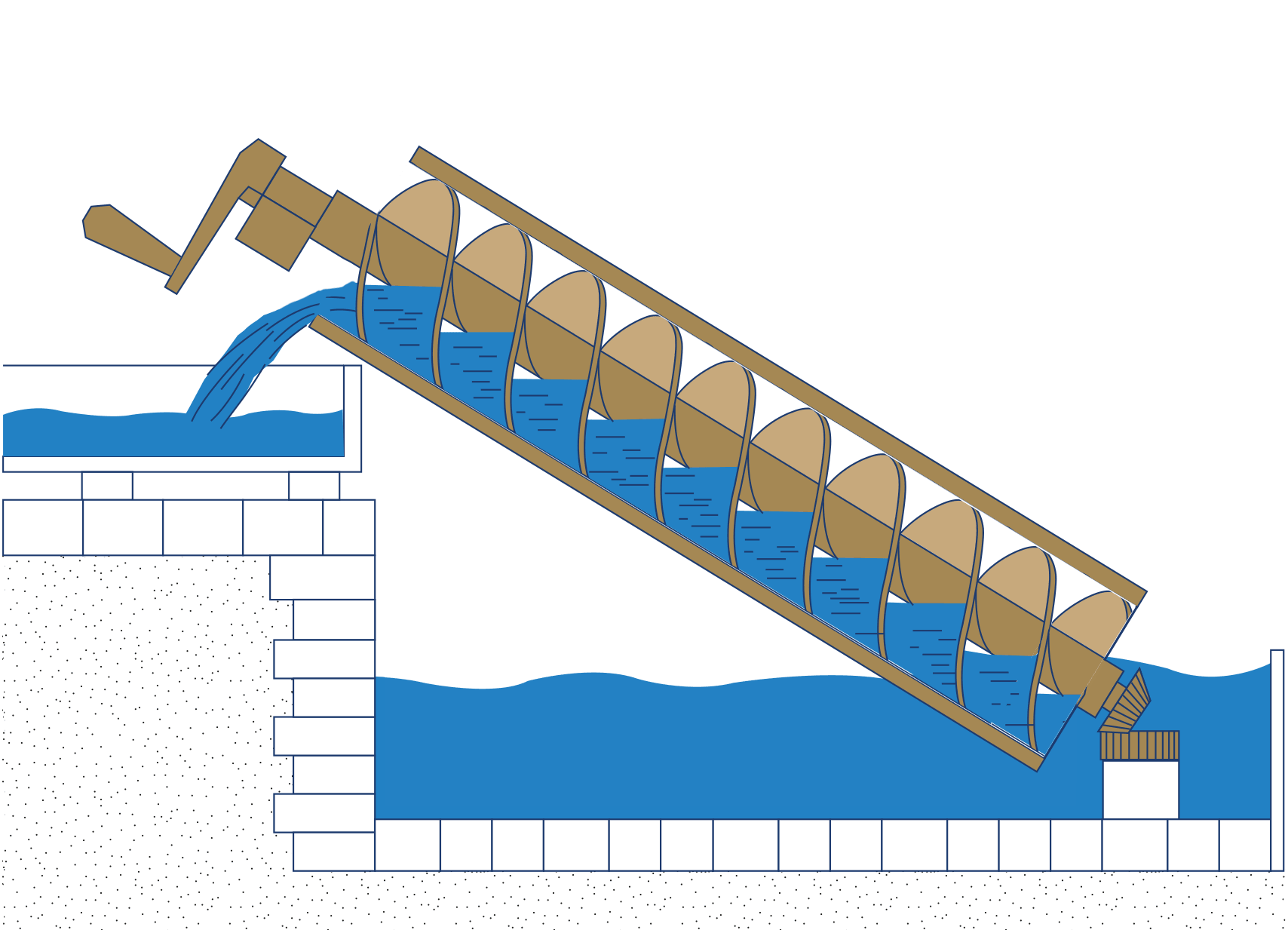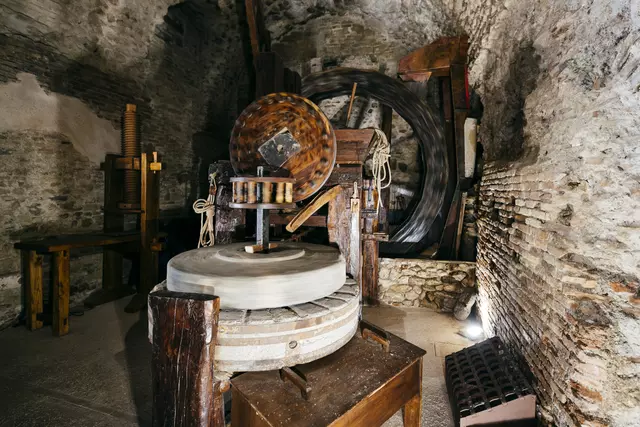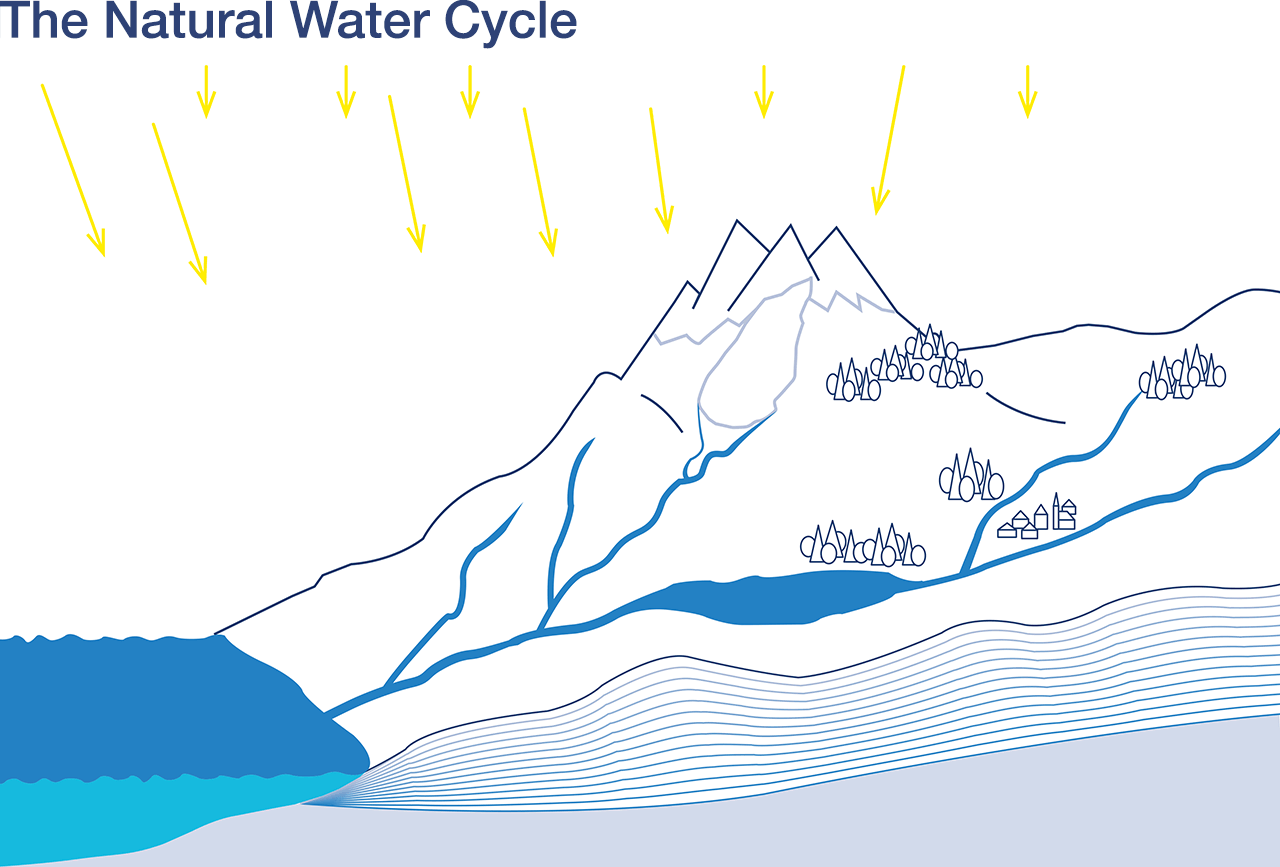What is hydropower?
When we talk about hydropower today, we are generally referring to the use of hydropower plants for the conversion of energy from flowing water to the electrical grid. Before the industrial revolution and electrification, the term was understood to mean the conversion of energy from water into mechanical energy in order to directly drive various devices.
The power of water has been used in this form for over 5000 years. The first use in antiquity was to draw water with vessels made of bamboo cane or clay to irrigate fields. Around 300 BC, the so-called Archimedean screw was invented for the same purpose. The use of hydropower has played an important role in the development of humankind. In recent times, water power has brought us clean, renewable electricity and in the past, water power was used to drive important machinery and applications.

After the invention of the Archimedean screw, the first water mills were built. In these mills, the flow of water was first used to grind grain or stones by means of wooden water wheels. Later, other applications followed according to the same principle, such as driving large wood saws in sawmills or for lifting heavy forging hammers in so-called hammer forges.




How hydropower plants work
The simplified student model below shows the turbine runner on the left, which is driven by flowing water. The turbine is connected to the generator either by a connecting shaft or a gearbox. The rotation of the magnets in the generator produces electricity, which makes the lamp light up.

Driven by water, driven by the sun
Hydropower, like wind power, is one of those renewable energy sources that enable the indirect use of solar energy to generate electricity. The sun is the "motor" for the movement of air masses and the water cycle. The sun's rays and the evaporation of water create clouds. Only the resulting precipitation in the form of rain and snow creates a natural, constantly renewing water cycle, which hydropower also makes use of. Hydropower can basically be used on any body of water if there is a sufficient gradient.


These are the different types of hydropower plants

Like water mills, run-of-river power plants use the energy of the flowing water of a river or stream. The energy is generated continuously and the output adjusts to the fluctuating water flow. Run-of-river power plants are the most common type of hydroelectric power plant.
Fig.: Functional principle of a run-of-river power plant


In storage power plants, water from natural bodies of water is accumulated in an upper reservoir by means of a dam. Electricity is produced on demand.
Fig:: Functional principle of a storage power plant


A pumped storage power plant has an upper and lower water reservoir: unlike storage power plants, the water can also be pumped up again when needed. These pumped-storage power plants are also very suitable for storing electrical energy and are often referred to as "green batteries". Because they can produce additional energy during peak demand, they help to stabilize the electrical grid.
Fig.: Functional principle of a pumped storage power plant

Hydropower worldwide

In 2016, hydropower plants with a cumulative capacity approximately 1,096 gigawatts (GW; 1 GW = 1,000 megawatts (MW)) were installed worldwide. The hydropower plant operators produced around 4,100 terawatt hours (TWh) of renewable energy. Hydropower supplied 16.6% of global demand and about 2/3 of total electricity generation from renewable sources, which covered 24.5% of world electricity demand.
The future of hydropower
Hydropower is the most proven renewable energy. It already has a considerable share in the electricity mix and will continue to play a major role in the future for the electricity supply and infrastructure of countries with sufficient water resources. There is still enormous untapped potential:

Advantages of hydropower at a glance
-
Environmentally friendly renewable energy with great potential for expansion throughout the world.
-
No raw material consumption as with fossil power plants (coal, oil, gas, etc.) and hardly any greenhouse gas emissions during operation (such as carbon dioxide, nitrogen oxides, hydrogen sulphide).
-
Twice the efficiency of fossil or nuclear power generation.
-
Simple and safe technology (no risks as great as nuclear power, for example).
-
Pumped storage power plants can also temporarily store large amounts of energy from the electricity grid, e.g. highly fluctuating wind and PV power.
-
Run-of-river power plants control river level regulation for navigable rivers.
-
Levels of the upper and lower water can be regulated in run-of-river power plants, Creating biotopes.
-
Energy generation is largely independent of seasons, times of day and the weather compared to wind and PV systems.
-
Flood protection through the presence of dams.
-
Reservoirs often also serve as regeneration or recreation sites.
-
Use of the reservoir as a drinking water reservoir and also for the irrigation of fields (water is also available in times of water scarcity)..
As one of the few full-range suppliers, the German company Voith has been building both large (from 30 MW) and small (up to 30 MW) hydropower plants since 1870. You can find more information here.
In Germany, the BDW (Bundesverband Deutscher Wasserkraftwerke e.V.) is the nationwide lobby group for the expansion of hydropower. The association also deals with energy policy and sees itself as the voice of hydropower on all relevant issues (e.g. the Renewable Energy Sources Act (EEG), grid-related issues or concerning the interests of hydropower plant operators). The BDW's organ is the publication „wassertriebwerk“. The BDW's goal is to maintain and further expand hydropower in Germany as a reliable source of energy.

